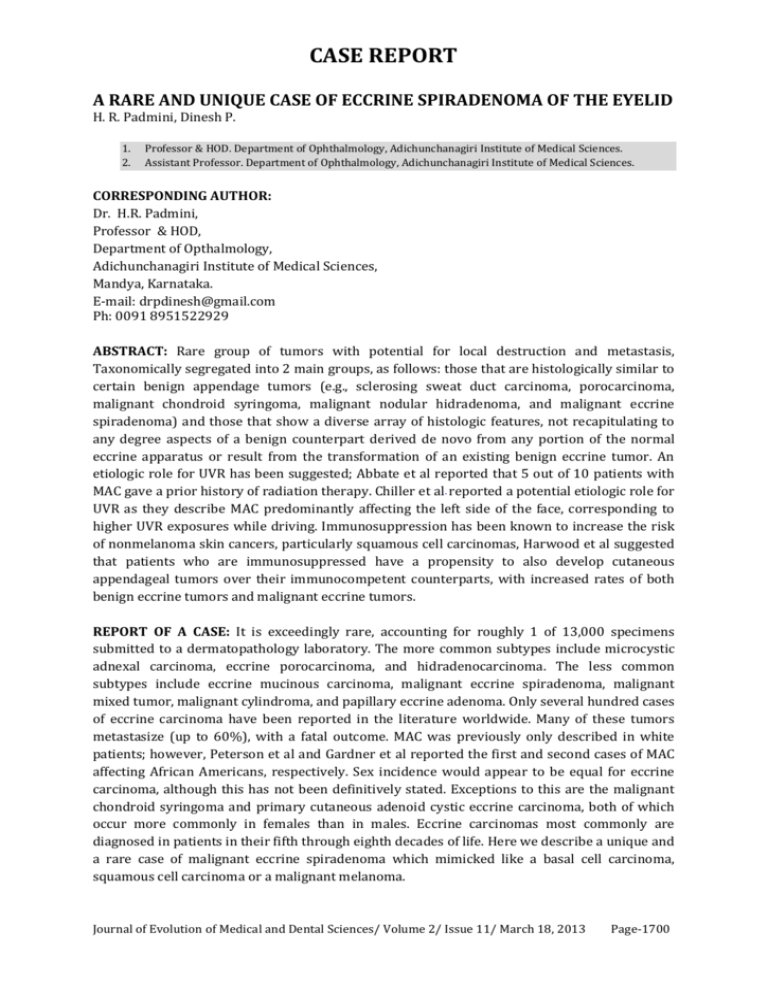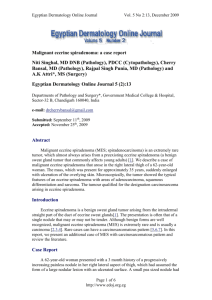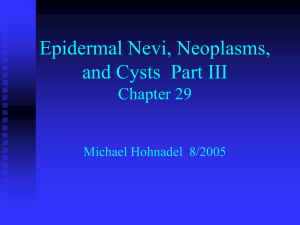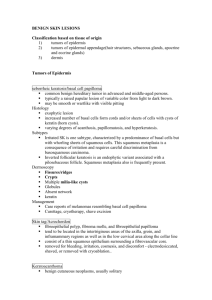HR Padmini, Dinesh P.
advertisement

CASE REPORT A RARE AND UNIQUE CASE OF ECCRINE SPIRADENOMA OF THE EYELID H. R. Padmini, Dinesh P. 1. 2. Professor & HOD. Department of Ophthalmology, Adichunchanagiri Institute of Medical Sciences. Assistant Professor. Department of Ophthalmology, Adichunchanagiri Institute of Medical Sciences. CORRESPONDING AUTHOR: Dr. H.R. Padmini, Professor & HOD, Department of Opthalmology, Adichunchanagiri Institute of Medical Sciences, Mandya, Karnataka. E-mail: drpdinesh@gmail.com Ph: 0091 8951522929 ABSTRACT: Rare group of tumors with potential for local destruction and metastasis, Taxonomically segregated into 2 main groups, as follows: those that are histologically similar to certain benign appendage tumors (e.g., sclerosing sweat duct carcinoma, porocarcinoma, malignant chondroid syringoma, malignant nodular hidradenoma, and malignant eccrine spiradenoma) and those that show a diverse array of histologic features, not recapitulating to any degree aspects of a benign counterpart derived de novo from any portion of the normal eccrine apparatus or result from the transformation of an existing benign eccrine tumor. An etiologic role for UVR has been suggested; Abbate et al reported that 5 out of 10 patients with MAC gave a prior history of radiation therapy. Chiller et al reported a potential etiologic role for UVR as they describe MAC predominantly affecting the left side of the face, corresponding to higher UVR exposures while driving. Immunosuppression has been known to increase the risk of nonmelanoma skin cancers, particularly squamous cell carcinomas, Harwood et al suggested that patients who are immunosuppressed have a propensity to also develop cutaneous appendageal tumors over their immunocompetent counterparts, with increased rates of both benign eccrine tumors and malignant eccrine tumors. REPORT OF A CASE: It is exceedingly rare, accounting for roughly 1 of 13,000 specimens submitted to a dermatopathology laboratory. The more common subtypes include microcystic adnexal carcinoma, eccrine porocarcinoma, and hidradenocarcinoma. The less common subtypes include eccrine mucinous carcinoma, malignant eccrine spiradenoma, malignant mixed tumor, malignant cylindroma, and papillary eccrine adenoma. Only several hundred cases of eccrine carcinoma have been reported in the literature worldwide. Many of these tumors metastasize (up to 60%), with a fatal outcome. MAC was previously only described in white patients; however, Peterson et al and Gardner et al reported the first and second cases of MAC affecting African Americans, respectively. Sex incidence would appear to be equal for eccrine carcinoma, although this has not been definitively stated. Exceptions to this are the malignant chondroid syringoma and primary cutaneous adenoid cystic eccrine carcinoma, both of which occur more commonly in females than in males. Eccrine carcinomas most commonly are diagnosed in patients in their fifth through eighth decades of life. Here we describe a unique and a rare case of malignant eccrine spiradenoma which mimicked like a basal cell carcinoma, squamous cell carcinoma or a malignant melanoma. Journal of Evolution of Medical and Dental Sciences/ Volume 2/ Issue 11/ March 18, 2013 Page-1700 CASE REPORT A 65 year old female presented with a single, asymptomatic, nondescript cutaneous lesion at the right lower lid margin, growing slowly over years, reaching a size of several centimeters over a few months. There was slight pain and pruritus but no spontaneous bleeding. There was no history of local trauma. Examination revealed a 2 x 1.8x1 cm blue grey firm, lobulated mass at the right lower lid margin near the lateral canthus. There were satellite papules surrounding the tumor. No significant lymphadenopathy was noted. Her past medical history was unremarkable. She denied any family members with similar skin findings or any history of skin cancers. Local examination revealed multiple, well-circumscribed, subcutaneous, blue-grey nodules near the right lower lid margin near the lateral canthus. The nodules were tender, firm, and fixed to the overlying skin. MRI demonstrated low-signal intensity on T1weighted images and high-signal intensity on short tau inversion recovery images. An excisional biopsy with lid reconstruction and cheek rotation flap was performed to obtain a representative sample of the lesion; this sample was sent for histopathologic evaluation to make the diagnosis. On histopathological examination the nodule consisted of sharply demarcated lobules located in the dermis without connection to the epidermis, there were groups of cells in cords, islands and sheets. Two types of cells were present; there were small, dark, basaloid cells with hyperchromatic nuclei and cells with large, pale, vesicular, and ovoid nuclei. The lesions were filled with lymphocytes. The Cells were arranged around small lumina, the Lumina contained small amounts of granular eosinophilic material that was PAS- positive, dilated vessels were seen. Excellent cosmetic and functional results were seen and as there were no metastases seen in the MRI, the patient was advised to return for future excisions in the case of increasingly painful or rapidly growing lesions. COMMENT: Spiradenomas seem to be caused by a defective tumor suppressor gene. In BrookeSpiegler syndrome, a defect exists in the CYLD gene located on chromosome 9. The actual cause of a solitary spiradenoma has yet to be defined. Radiation, hyperthermic limb perfusion chemotherapy, and chemotherapy are used in the treatment of malignant spiradenomas, the mainstay of treatment of spiradenomas and malignant spiradenomas is surgical removal, Mohs micrographic surgery offers the most conservative treatment choice Multiple spiradenomas, such as those found in Brooke-Spiegler syndrome can be treated with a high-energy continuous wave carbon dioxide laser after debulking with bipolar scissors. Debulking with bipolar scissors prior to laser therapy can be a beneficial technique in the surgical removal of large tumors. Management during the course of metastatic spiradenoma includes surgery, radiation therapy, hyperthermic limb perfusion chemotherapy, and chemotherapy, in particular tamoxifen. Surgery is usually curative; therefore, further care is not needed. If malignant spiradenomas occur, the patient will need to follow up with oncologists, radiation oncologists, and radiologists. Most spiradenomas are benign and stable and do not require treatment. Malignant spiradenomas require treatment, and it is metastatic in about 50% of cases. If metastatic and untreated, malignant spiradenomas are fatal. REFERENCES: 1. Kazakov DV, Soukup R, Mukensnabl P, Boudova L, Michal M. Brooke-Spiegler syndrome: report of a case with combined lesions containing cylindromatous, spiradenomatous, trichoblastomatous, and sebaceous differentiation. Am J Dermatopathol. Feb 2005;27(1):27-33. Journal of Evolution of Medical and Dental Sciences/ Volume 2/ Issue 11/ March 18, 2013 Page-1701 CASE REPORT 2. Chen G, Cheuk W, Cheung JS, Chan JK. Carcinosarcoma ex eccrine spiradenoma of the vulva: report of the first case. Int J Gynecol Pathol. May 2011;30(3):301-5 3. Gupta S, Radotra BD, Kaur I, Handa S, Kumar B. Multiple linear eccrine spiradenomas with eyelid involvement. J Eur Acad Dermatol Venereol. Mar 2001;15(2):163-6 4. Turhan-Haktanir N, Demir Y, Tokyol C. A case of eccrine spiradenoma arising in nevus sebaceous in an adolescent girl. Am J Dermatopathol. Apr 2008;30(2):196-7. 5. Gordon S, Styron BT, Haggstrom A. Pediatric Segmental Eccrine Spiradenomas: A Case Report and Review of the Literature. Pediatr Dermatol. May 21 2012 6. Saboorian MH, Kenny M, Ashfaq R, Albores-Saavedra J. Carcinosarcoma arising in eccrine spiradenoma of the breast. Report of a case and review of the literature. Arch Pathol Lab Med. May 1996;120(5):501-4. 7. Tiradogonzalez M, Beierle E, Hammers Y, Andea A, Mroczek E. Neonatal Spiradenoma. Pediatr Dermatol. Jul 2 2012 8. Yildirim S, Akoz T, Akan M, Ege GA. De novo malignant eccrine spiradenoma with an interesting and unusual location. Dermatol Surg. Apr 2001;27(4):417-20. 9. Clarke J, Ioffreda M, Helm KF. Multiple familial trichoepitheliomas: a folliculosebaceousapocrine genodermatosis. Am J Dermatopathol. Oct 2002;24(5):402-5. 10. Mambo NC. Eccrine spiradenoma: clinical and pathologic study of 49 tumors. J Cutan Pathol. Oct 1983;10(5):312-20. 11. Kao GF, Laskin WB, Weiss SW. Eccrine spiradenoma occurring in infancy mimicking mesenchymal tumor. J Cutan Pathol. Aug 1990;17(4):214-9. 12. Amoroso C, Grandi E, Carinci F. Eccrine spiradenoma of the ear: case report. Int J Oral Maxillofac Surg. Dec 2003;32(6):662-3. Journal of Evolution of Medical and Dental Sciences/ Volume 2/ Issue 11/ March 18, 2013 Page-1702 CASE REPORT Journal of Evolution of Medical and Dental Sciences/ Volume 2/ Issue 11/ March 18, 2013 Page-1703









